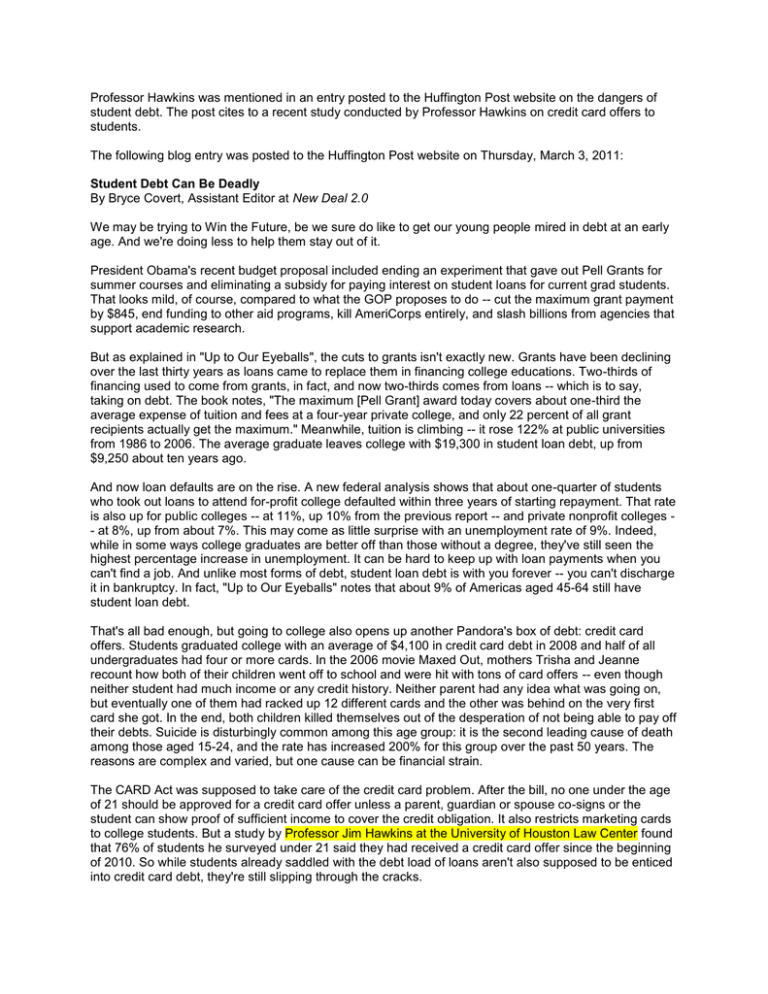Professor Hawkins was mentioned in an entry posted to the... student debt. The post cites to a recent study conducted...
advertisement

Professor Hawkins was mentioned in an entry posted to the Huffington Post website on the dangers of student debt. The post cites to a recent study conducted by Professor Hawkins on credit card offers to students. The following blog entry was posted to the Huffington Post website on Thursday, March 3, 2011: Student Debt Can Be Deadly By Bryce Covert, Assistant Editor at New Deal 2.0 We may be trying to Win the Future, be we sure do like to get our young people mired in debt at an early age. And we're doing less to help them stay out of it. President Obama's recent budget proposal included ending an experiment that gave out Pell Grants for summer courses and eliminating a subsidy for paying interest on student loans for current grad students. That looks mild, of course, compared to what the GOP proposes to do -- cut the maximum grant payment by $845, end funding to other aid programs, kill AmeriCorps entirely, and slash billions from agencies that support academic research. But as explained in "Up to Our Eyeballs", the cuts to grants isn't exactly new. Grants have been declining over the last thirty years as loans came to replace them in financing college educations. Two-thirds of financing used to come from grants, in fact, and now two-thirds comes from loans -- which is to say, taking on debt. The book notes, "The maximum [Pell Grant] award today covers about one-third the average expense of tuition and fees at a four-year private college, and only 22 percent of all grant recipients actually get the maximum." Meanwhile, tuition is climbing -- it rose 122% at public universities from 1986 to 2006. The average graduate leaves college with $19,300 in student loan debt, up from $9,250 about ten years ago. And now loan defaults are on the rise. A new federal analysis shows that about one-quarter of students who took out loans to attend for-profit college defaulted within three years of starting repayment. That rate is also up for public colleges -- at 11%, up 10% from the previous report -- and private nonprofit colleges - at 8%, up from about 7%. This may come as little surprise with an unemployment rate of 9%. Indeed, while in some ways college graduates are better off than those without a degree, they've still seen the highest percentage increase in unemployment. It can be hard to keep up with loan payments when you can't find a job. And unlike most forms of debt, student loan debt is with you forever -- you can't discharge it in bankruptcy. In fact, "Up to Our Eyeballs" notes that about 9% of Americas aged 45-64 still have student loan debt. That's all bad enough, but going to college also opens up another Pandora's box of debt: credit card offers. Students graduated college with an average of $4,100 in credit card debt in 2008 and half of all undergraduates had four or more cards. In the 2006 movie Maxed Out, mothers Trisha and Jeanne recount how both of their children went off to school and were hit with tons of card offers -- even though neither student had much income or any credit history. Neither parent had any idea what was going on, but eventually one of them had racked up 12 different cards and the other was behind on the very first card she got. In the end, both children killed themselves out of the desperation of not being able to pay off their debts. Suicide is disturbingly common among this age group: it is the second leading cause of death among those aged 15-24, and the rate has increased 200% for this group over the past 50 years. The reasons are complex and varied, but one cause can be financial strain. The CARD Act was supposed to take care of the credit card problem. After the bill, no one under the age of 21 should be approved for a credit card offer unless a parent, guardian or spouse co-signs or the student can show proof of sufficient income to cover the credit obligation. It also restricts marketing cards to college students. But a study by Professor Jim Hawkins at the University of Houston Law Center found that 76% of students he surveyed under 21 said they had received a credit card offer since the beginning of 2010. So while students already saddled with the debt load of loans aren't also supposed to be enticed into credit card debt, they're still slipping through the cracks. The country already came to the conclusion that we should restrict marketing tobacco products to minors because they can kill you. Debt can also be deadly. Why are we allowing them to take on so much so early on?






